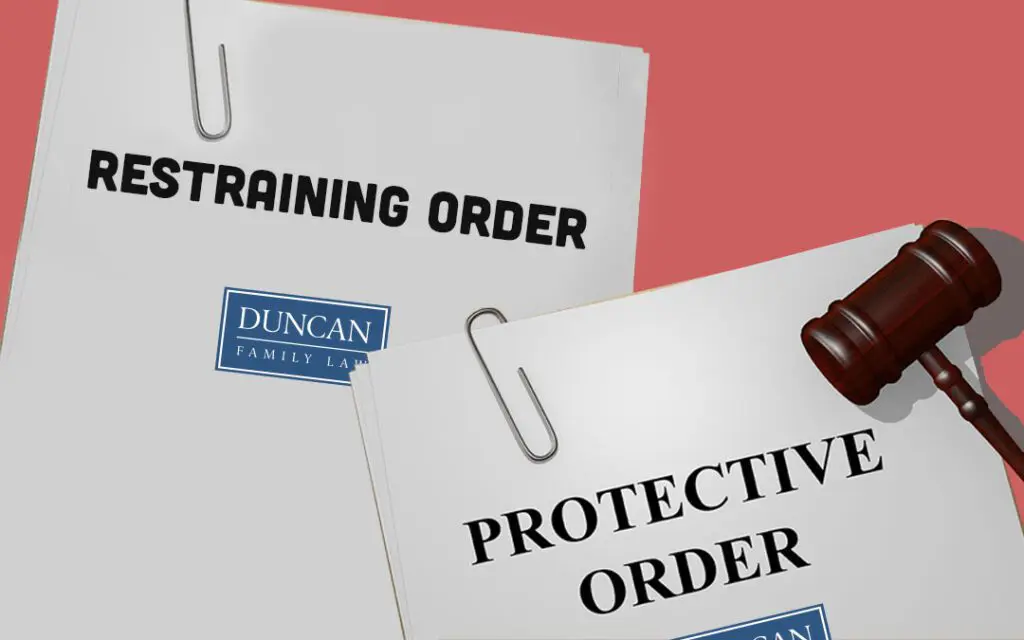In the US, protective orders and restraining orders serve different purposes and are associated with different legal proceedings. Here are the key differences:
Protective Order
- Associated with: Criminal cases, particularly in cases of family violence, human trafficking, or stalking. Civil protection orders are a type of protective order used in legal proceedings aimed at preventing harm.
- Types: Emergency protective orders, temporary ex parte protective orders, and permanent (or final) protective orders.
- Enforceability: Violations can lead to criminal charges.
- Duration: Can last up to ten years from the issue date in Texas.
Restraining Order
Associated with: Civil case proceedings, such as divorce or lawsuits. A temporary restraining order can be issued without the respondent’s prior notification for a limited duration.
Enforceability: Violations are generally not criminally enforceable and may result in civil remedies or contempt of court.
Duration: Typically concludes with the end of the lawsuit or upon agreement of the parties.
In summary, protective orders are associated with criminal cases and are used to prevent acts of family violence, while restraining orders are associated with civil case proceedings and are more broad, often applying to both parties involved in the case. Violations of protective orders can lead to criminal charges, while violations of restraining orders are generally not criminally enforceable. Seeking guidance from a trusted Los Angeles Domestic Violence Attorney ensures you understand the legal implications of protective and restraining orders and how they apply to your unique situation.
Understanding Orders
Legal Definitions
Legal orders are tools used by courts to enforce laws or grant specific rights. They come in various forms, depending on the situation and need. A court might issue an order to resolve a dispute, protect someone, or ensure that justice is served.
The purpose of legal orders is vast. They can range from resolving financial disputes to protecting individuals from harm. When a court issues an order, it’s legally binding. This means everyone involved must follow the court’s decision.
Protection orders specifically aim to keep someone safe. Protective orders and restraining orders fall under this category but serve different needs based on the situation.
Courts play a crucial role in issuing these orders. They evaluate each case carefully before deciding whether an order is necessary and what type it should be.
General legal orders cover a wide range of issues beyond just protection. For example, they might relate to property disputes or contractual obligations.
However, protective and restraining orders focus solely on safety concerns.
- Protective orders usually involve domestic violence situations.
- Restraining orders can apply more broadly to prevent harassment or stalking by anyone against another person.
Differentiating between general legal orders and those for protection helps clarify their purposes:
- General legal orders manage civil matters like business agreements.
- Protection-oriented ones prioritize individual safety above all else.
Understanding these distinctions makes navigating the legal system easier for people seeking help.
Protection Order vs Restraining Order
Key Differences
Protective and restraining orders are legal tools. They help keep people safe from harm. But, they are not the same.
A protective order is broader than a restraining order. It often involves cases of domestic violence or stalking. Courts issue it to stop specific acts against someone seeking protection. Violating a civil protection order is categorized as a criminal offense, which carries more severe penalties.
Restraining orders, on the other hand, are more about stopping harassment or abuse in non-domestic situations. They can also apply in civil disputes between neighbors or coworkers.
The statutory basis for each differs too. Protective orders come under family law because they often involve family members or intimate partners. Restraining orders fall under civil law.
To get a protective order, one must show proof of abuse or threats of violence. For a restraining order, the criteria might be less stringent but still require evidence of harassment or harm.
Similarities
Despite their differences, these two types of orders share common goals. Both aim to protect individuals from harm and maintain peace.
They offer various levels of protection depending on what’s needed. This might include no contact directives, staying away from certain places, or not possessing firearms.
The duration for both can vary widely. Some last only until a court hearing takes place. Others may extend for years based on the situation’s severity and legal judgments made.
Types of Orders in California
Protective Orders
Protective orders and restraining orders share common goals. They aim to protect individuals from harm or harassment. A law enforcement officer can assist individuals in obtaining a protective order. Both types of orders have similar legal processes for obtaining them. This includes filing a petition in court and presenting evidence of the need for protection.
The enforcement mechanisms are also alike. Violating either order can lead to criminal charges. Police enforce these orders strictly to ensure safety.
Restraining Orders
Restraining orders come into play in specific scenarios. These include domestic violence, stalking, or threats. A police officer can request an emergency protective order by contacting a judge through a hotline. The main goal is to prevent further harm by creating physical distance between the involved parties.
These orders offer various protections:
- No contact directives.
- Limits on approaching the protected person’s home or workplace.
- Temporary custody arrangements in cases involving children.
Anyone feeling threatened can request a protective order. Victims of abuse, stalking, or harassment often seek these measures as a shield against further violations.
Emergency Orders
California’s Emergency Protection System
California has a unique approach to emergency protection. The state allows for both protective and restraining orders. These serve as shields for those threatened or harmed. Law enforcement plays a crucial role here.
Understanding the court proceedings involved in obtaining these orders is crucial for ensuring both parties’ rights are respected.
When an emergency order is issued, it acts fast. It offers immediate safety for victims of abuse or threats. This emergency protective order can be requested by police officers on behalf of the victim. It starts working right away but lasts only a short time.
Violating these orders in California is serious business. The consequences are severe and swift.
- Jail time
- Fines
- Mandatory counseling
These penalties aim to deter future violations.
Law enforcement officers have the authority to enforce these orders 24/7. They ensure violators face legal action swiftly.
Order Details
A civil protection order or a restraining order can have significant implications on your daily life. Understanding the specifics of the order is crucial to avoid any unintended violations. Here are some key details to consider:
- Duration: A civil protection order can be issued for a specific period, usually up to one year, but can be extended if necessary. A restraining order, on the other hand, can be temporary or permanent, depending on the circumstances.
- Restrictions: Both types of orders can restrict your movements, interactions, and behavior, including:- Staying away from the petitioner or protected person
- Not contacting the petitioner or protected person
- Not going near the petitioner’s home, work, or other specified locations
- Not possessing a firearm
- Not engaging in any other behavior that could cause harm to the petitioner or protected person
- Consequences of Violations: Violating a civil protection order or a restraining order can result in severe consequences, including arrest, fines, and even jail time.
Understanding these details can help you comply with the order and avoid any legal repercussions.
Impact of Violating a Restraining Order
In the U.S., breaking a restraining order can lead to serious consequences, which differ by state:
- Misdemeanor Charges: Typically, violating a restraining order is a misdemeanor. This can lead to up to one year in jail and fines of several thousand dollars.
- Felony Charges: If the violation involves another crime, such as assault, it can be classified as a felony, with prison terms of five years or more.
- State-Specific Penalties: Penalties differ by state. For instance, in Virginia, a first-time violation may result in up to one year in jail, while repeated offenses (three or more) are considered a Class 6 felony, with up to five years’ imprisonment.
Violating such an order can lead to severe legal consequences.
Other possible consequences include probation, mandatory domestic violence classes, and covering related costs. The penalties can depend on the nature of the violation, prior offenses, and the state’s laws.
California Restraining Orders
California has strict laws for restraining orders, with clear distinctions between temporary (emergency) and full orders. Temporary orders offer immediate, short-term protection, while full orders last longer.
Compared to other states, California:
- Issues emergency orders quickly.
- Enforces orders immediately with prompt law enforcement responses.
- Allows victims to communicate directly with law enforcement.
These measures ensure swift protection for those in need.
Duration and Renewal
Temporary protective and restraining orders are issued in emergencies or before a full court hearing. They typically last several weeks, depending on the jurisdiction, and provide urgent protection.
Violating these orders can lead to jail time, fines, and affect future court cases, including family law or custody proceedings. After a temporary order expires, a full hearing may determine whether a long-term order is necessary.
Renewal of these orders is often necessary if the threat remains, and it’s essential to act promptly to avoid any lapse in protection.
Legal Proceedings for Orders
The process of filing and renewing a court order, such as a restraining order, requires understanding expiration terms and renewal steps:
- Protective Orders: Generally valid for up to two years, with renewal options if the threat persists.
- Restraining Orders: Duration and renewal depend on state laws and case details. Renewals need proof of continued risk.
In cases of changed circumstances, early termination of an order can be requested by either party.
Filing Steps
To get a protective or restraining order, you must:
- Gather evidence, such as any history of threats, harassment, or violence.
- Complete forms available at courthouses or online.
- Submit the forms with evidence and any related reports to law enforcement.
Fees apply but may be waived for financial hardship.
Criminal vs. Civil Consequences of Violation
Breaking a restraining order can lead to either criminal charges, like jail time, or civil consequences, such as mandatory counseling. Criminal violations bring harsher penalties, while civil violations often aim to prevent further harm rather than punish past actions.
Law Enforcement’s Role
Law enforcement is critical in enforcing court orders and handling violations. They distinguish between criminal and civil actions, and their response can vary by jurisdiction, with some areas imposing stricter penalties.
For victims, understanding local enforcement provides reassurance, while respondents benefit by knowing how to avoid unintentional violations.
Protective Measures for Children
Purpose and Function
Law enforcement plays a crucial role in upholding protective orders and restraining orders. When someone reports a violation, officers act quickly. They first confirm the existence of an order. Then, they assess the situation to protect those involved.
Officers often work with other agencies, especially in cases that cross city or state lines. This coordination is vital for ensuring safety everywhere.
For example, if a parent with a restraining order moves states, local police will work with out-of-state counterparts. They ensure the protective measures stay strong.
Protecting Children from Domestic Violence
The primary goal here is straightforward: keep children safe from harm. These legal tools are designed to prevent danger before it happens.
But there’s more to it than just immediate safety.
- Deterrence: Knowing there are serious consequences can stop harmful actions before they start.
- Societal impacts: Wider benefits include raising awareness about domestic issues and promoting safer communities.
Let’s consider how these measures help beyond just stopping direct threats.
- Schools become aware of potential risks.
- Neighbors look out for each other more.
- Communities grow stronger as they stand against violence together.
Seeking Help
If you are facing a civil protection order or a restraining order, it is essential to seek help from an experienced domestic violence attorney. A skilled lawyer can help you understand the specifics of the order, navigate the legal process, and protect your rights.
- Benefits of Legal Assistance: A defense attorney can help you understand the terms of the order and what is expected of you.
- Developing a Strategy: They can develop a strategy to defend against the order or negotiate a resolution.
- Court Representation: An attorney can represent you in court and advocate on your behalf.
- Protecting Your Rights: They ensure that your rights are protected throughout the process.
Don’t face a civil protection order or a restraining order alone. Seek the help of an experienced attorney who can guide you through the process and protect your interests.
Frequently Asked Questions
What’s the difference between a protective order and a restraining order?
Protective orders are typically used in cases of domestic violence to keep the abuser away from their victim. Restraining orders, on the other hand, can be broader, covering situations like stalking or harassment by anyone.
Who can request a protective order in California?
If you’re facing threats or abuse from someone close to you—think family members or intimate partners—you can request a protective order. It’s designed to protect individuals in personal relationships.
How long does an emergency protective order last?
In California, an emergency protective order is quick relief that lasts only up to 7 days. It’s like putting a band-aid on a wound until you get stitches—it gives immediate but temporary protection.
Can I renew my restraining or protective order before it expires?
Yes! You’ll need to apply for renewal before your current order expires if you still feel threatened.
What happens if someone violates a restraining or protective order?
Violating these orders is serious business—it’s not just crossing a line; it’s breaking the law. The violator could face arrest, fines, or even jail time depending on the severity of the violation.
Are there special protections for children under these orders?
Absolutely! Protective measures for children are tailored like clothes made just for them—ensuring they’re safe from harm within their own unique circumstances.






